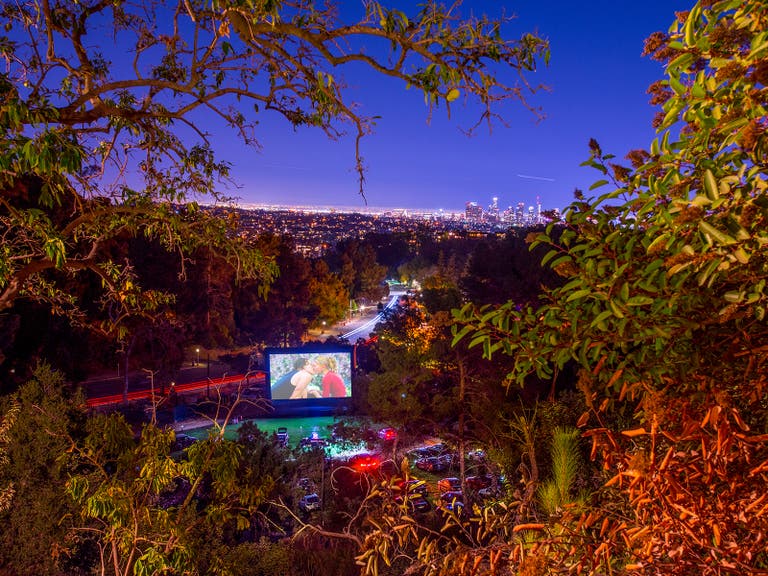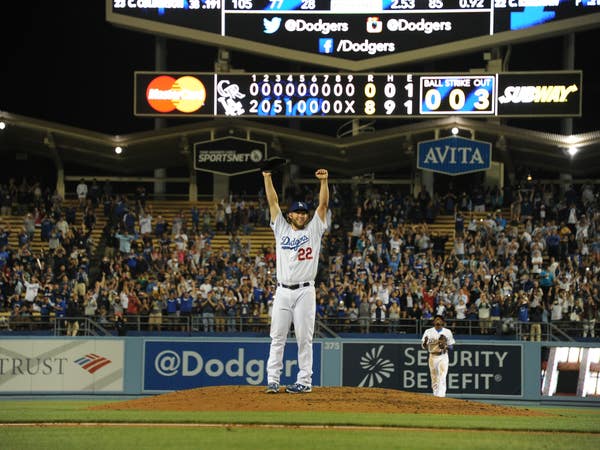Celebrate Modernism in Los Angeles
Discover authentic Mid-Century masterpieces in LA
For architecture geeks and scholars, Los Angeles is a mecca for Modernism. From iconic residences to stunning public buildings, discover Mid-Century masterpieces in LA.
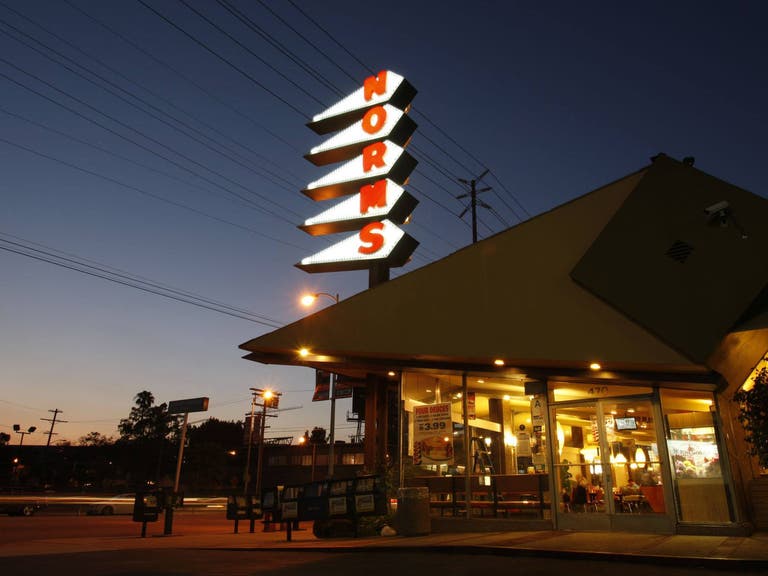
Norms La Cienega
This longest operating NORMS restaurant is considered one of the finest examples of LA’s Googie eateries. Opened in 1957, NORMS La Cienega was designed by the famed architecture firm Armet & Davis, with an interior designed by pioneering architect Helen Liu Fong. Thanks to the efforts of the Los Angeles Conservancy, the Cultural Heritage Commission, and Councilmember Paul Koretz, NORMS La Cienega was declared a Historic-Cultural Monument in May 2015 and saved from imminent destruction.
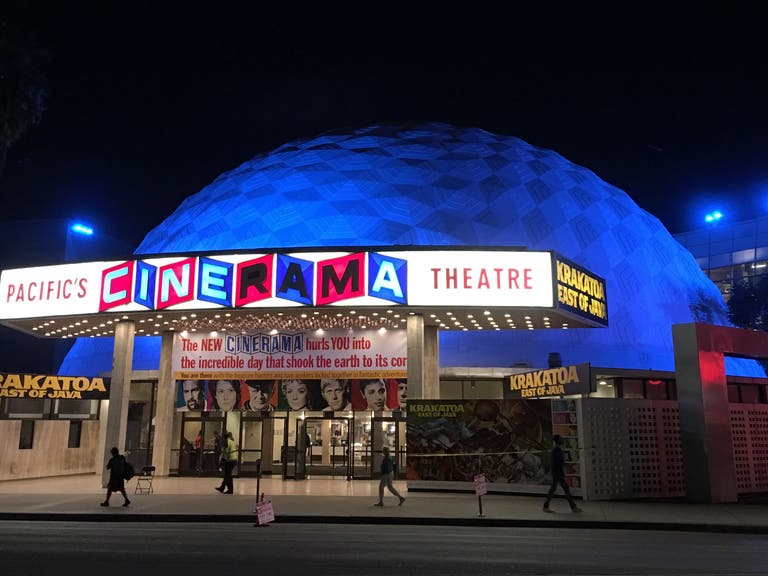
Cinerama Dome
Quentin Tarantino’s favorite place to see a movie, the Cinerama Dome was designed by Welton Becket and opened on Nov. 7, 1963. Currently closed due to the pandemic, the Cinerama Dome was the world's first concrete geodesic dome and is one of only three surviving theatres with a curved screen that can show movies in the three-projector Cinerama format. Movie fans are eager for the reopening of the Dome so they can once again watch the latest blockbusters and classic films on the 32-by-86 foot screen.
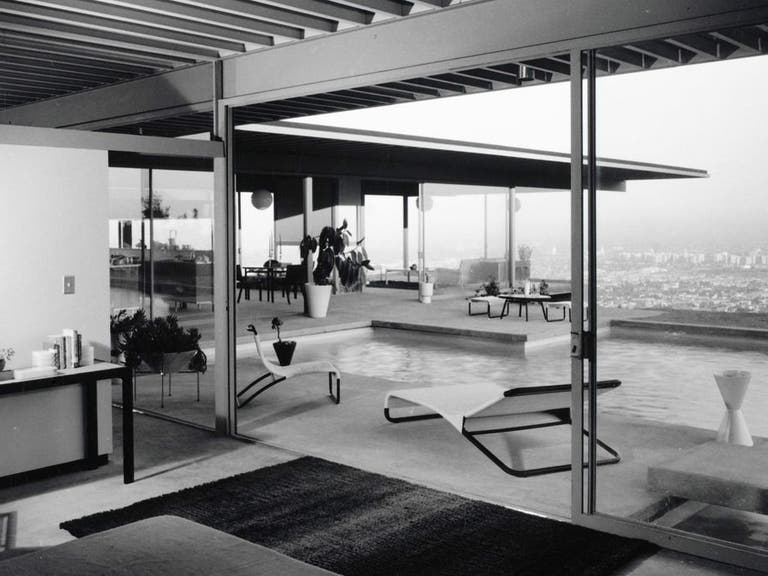
Stahl House (Case Study House No. 22)
Photographer Julius Shulman’s iconic photo of this house was named by TIME magazine as one of the 100 most influential photographs in the history of the medium. You can reenact the scene during a sublime sunset tour of Pierre Koenig’s Case Study House No. 22, aka the Stahl House (1960). It’s a view of Los Angeles that will give you feels for the city and historic architecture you didn’t know you had.
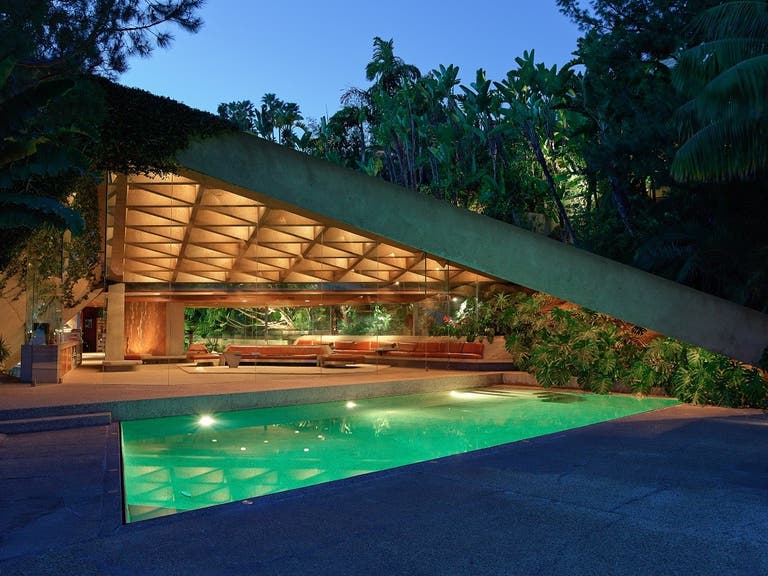
Sheats-Goldstein Residence
Perhaps most recognized by The Big Lebowski fans as porn magnate Jackie Treehorn’s estate, the Sheats-Goldstein Residence is one of the best-known examples of John Lautner's work. The full range of the architect’s talents are realized, as he designed literally everything from the furniture to the light switches. Even the James Turrell Art installation on the premises, “SKYspace” was originally conceived as a collaboration between the architect and the artist - however, Lautner passed away before its completion. Not to worry, the current owner has bequeathed the house to LACMA.
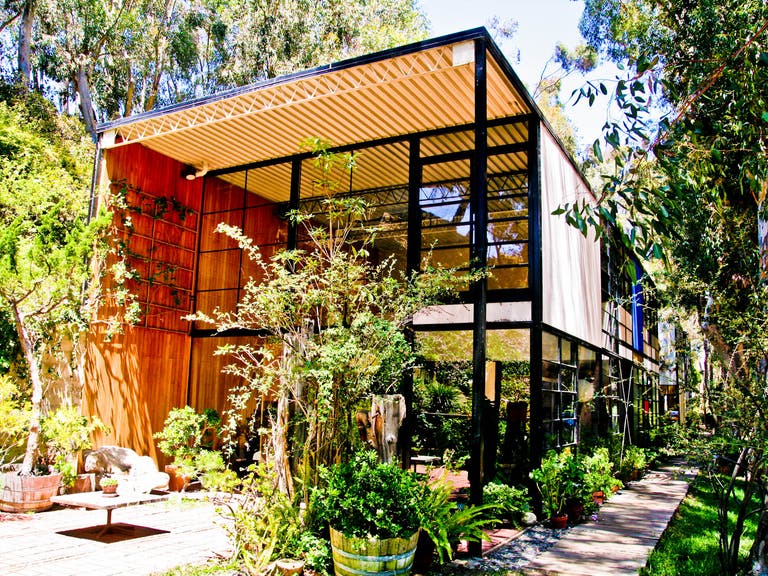
Eames House (Case Study House No. 8)
Known formally as Case Study House No. 8, the Eames House is a Mid-Century Modern architectural landmark located in Pacific Palisades. It was built in 1949 by renowned husband-and-wife designers Charles and Ray Eames, serving as their home and studio. According to the Eames Foundation, the interior, its objects and its collections “remain very much the way they were in Charles and Ray’s lifetimes.” The Eames House is regarded as the most successful of the 25 Case Study Houses that were sponsored by Arts & Architecture magazine, which commissioned major architects to design and build model homes for the postwar U.S. housing boom. In September 2006, the Eames House was added to the National Register of Historic Places and designated a National Historic Landmark. It was designated Los Angeles Historic-Cultural Monument #381 in July 1988. Tours of the exterior and interiors are available for those who want to see the iconic “chairs” in their natural habitat.
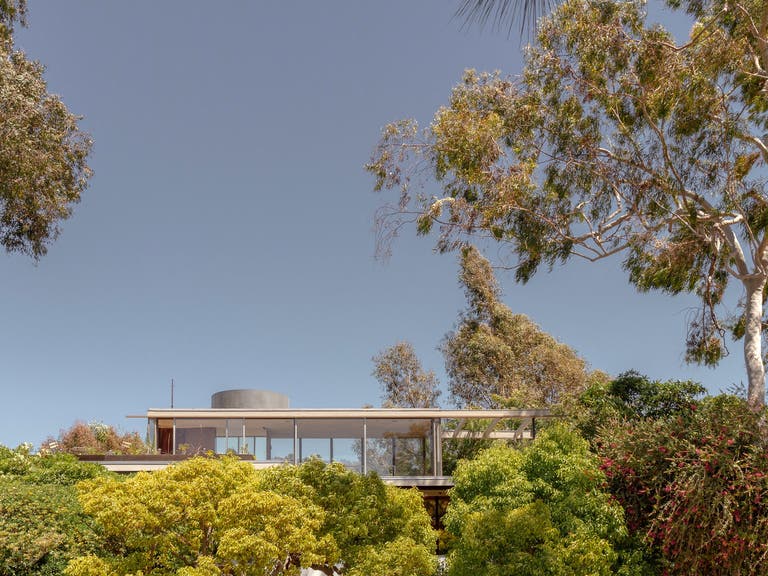
Neutra Studio/Residences (VDL Research House II)
The only Richard Neutra-designed house that is now open regularly to the public, the Neutra VDL Studio and Residences is a Silver Lake hidden gem that was built by the famed architect in 1932. He ran his practice out of a studio here, and along with his wife Dione raised three sons in this house, which he designed to demonstrate that Modernist principles could be enjoyed by less affluent clients, while maintaining privacy. Natural light, glass walls, patios and mirrors are hallmarks.
In January 2017, the Neutra VDL Studio and Residences was added to the National Register of Historic Places. The U.S. Department of the Interior press release describes Neutra as "a nationally and internationally seminal figure of the twentieth century Modern movement in architecture" and the VDL Research House as "the only property where one can see the progression of his style over a period of years and is among the key properties to understanding the national significance of Richard Neutra.”
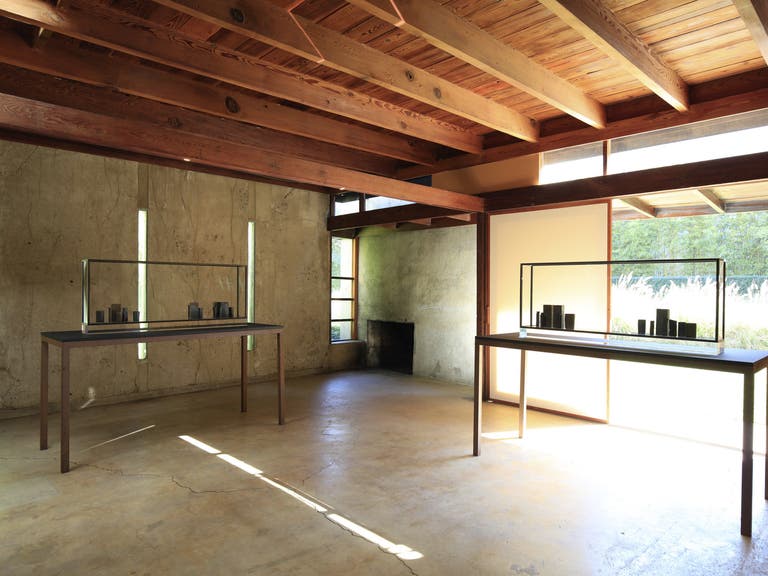
Schindler House
When this residential house was built by Vienna-born Rudolf Schindler in 1922 - inspired by a recent trip to Yosemite with his wife - it was extremely unconventional at the time for a place to live. In reality, it was meant to be a cooperative live-work space between two families, much like a campsite. Having been the residence of the Schindlers and then other creatives, this WeHo hidden gem is now listed on the National Register of Historic Places and is open to the public Wednesday through Sunday as the headquarters of the MAK Center for Art and Architecture, a satellite of the MAK - Austrian Museum of Applied Arts / Contemporary Art in Vienna.
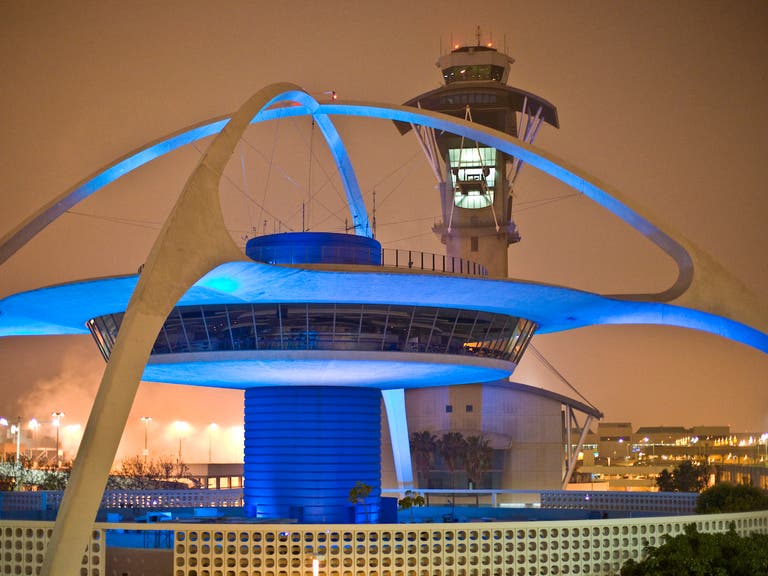
Theme Building at LAX
Architect Paul R. Williams’ atomic masterpiece, the Theme Building greets travelers as they arrive at LAX. A beacon of mid-century modernism, this futuristic, Googie-style building used to house a restaurant that has since closed. Originally constructed as the intended center hub of the airport, surrounded by a number of radiating terminals, plans were scaled back considerably as construction began. The Theme Building was named a Los Angeles Historic Monument (#570) in 1993.
The Bob Hope USO Center opened at the Theme Building in July 2018. The 7,100 square-foot center hosts tens of thousands of service members and families per month and features a snack bar, outdoor patio seating, nap room, private family rooms, movie room, children’s play area, plus space to store luggage and charge electronics.
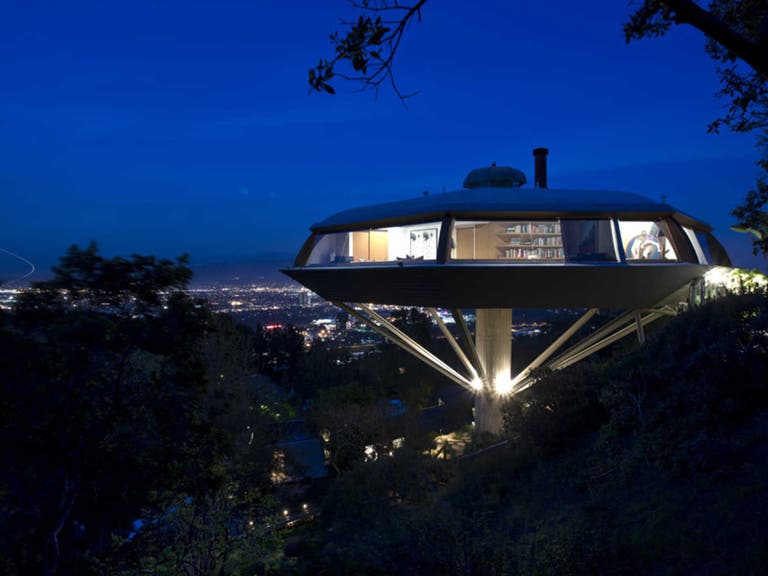
Chemosphere
Hidden in the Hollywood Hills, this peculiar concrete octagon designed by John Lautner in 1960 seems to sail above the treetops. Known as the Chemosphere, this fantastical house has its own funicular (think Angels Flight) and is connected to the hillside by a singular patio. Even if you don’t know or care about Modernism, you will recognize this building as something special. Commissioned by Leonard Malin - a young aerospace engineer with $30,000 to burn - the Chemosphere was completed in 1960 and remains the most modern example of Mid-Century architecture that still exists.
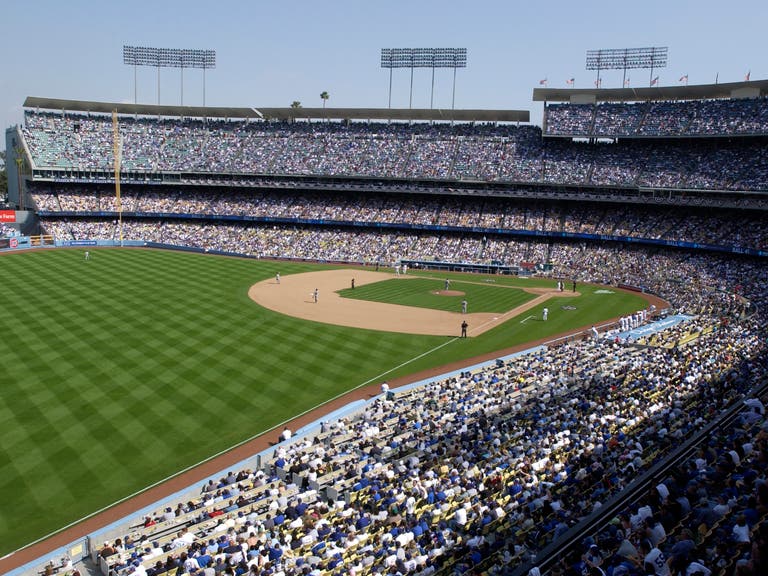
Dodger Stadium
Dodger Stadium is the home field of the Los Angeles Dodgers and one of the true cathedrals of Major League Baseball. Since opening its gates in 1962, the storied modernist ballpark has hosted eight World Series and the Dodgers have won four World Championships. Through the decades, Dodger Stadium has seen Hall of Famers, World Champions, no-hitters, MVPs and Cy Young Award winners. The stadium is also one of the greatest entertainment venues in the country, hosting special events that range from the Beatles to Beyonce, the Pope, the NHL Stadium Series, and the Harlem Globetrotters.
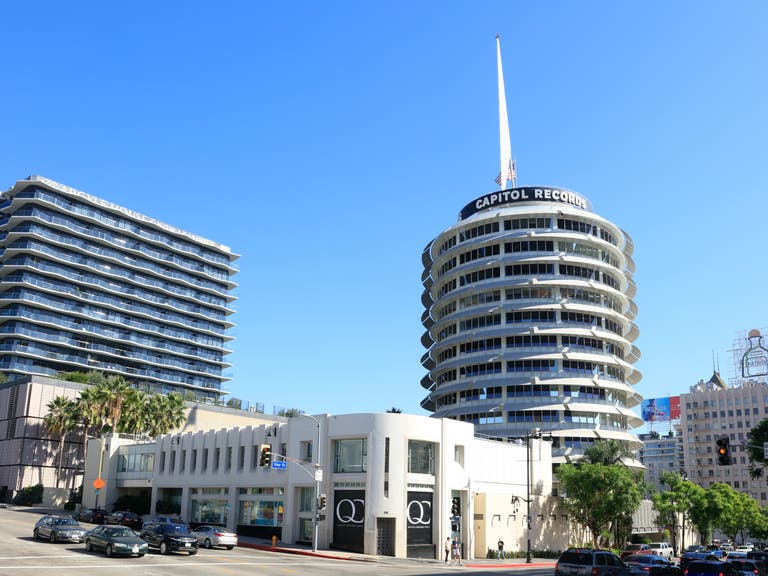
Capitol Records Building
Located just north of the famed intersection of Hollywood and Vine, the landmark Capitol Records Building was designed by Welton Becket, the architect who also designed the Music Center, Cinerama Dome, and Santa Monica Civic Auditorium. The 13-story tower, which resembles a stack of records, was the world’s first circular office building when it was completed in April 1956.
The Capitol Records Building is the site of the historic Capitol Studios, where Frank Sinatra, The Beach Boys, Nat “King” Cole, Sir Paul McCartney, and many more music legends recorded some of the most treasured music in history. Fun fact: the blinking spire at the top of the "needle" spells out HOLLYWOOD in morse code.
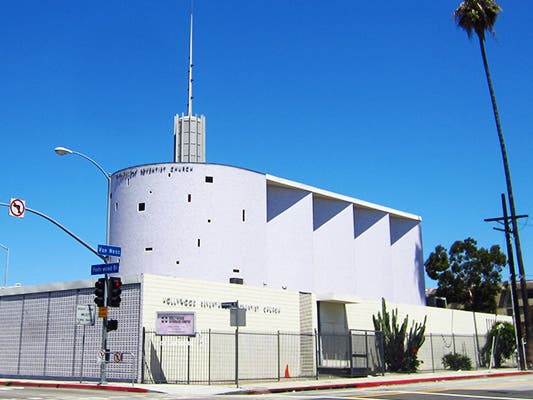
Hollywood Adventist Church
The Hollywood Adventist Church is a Seventh-day Adventist congregation, easily seen from its location on Hollywood Boulevard and Van Ness, just off the 101 Freeway. Of the uniquely-designed building, with its mixed-bag architectural style and purple exterior, musician and architecture geek, Moby said simply, “There’s a weird beauty to it.”
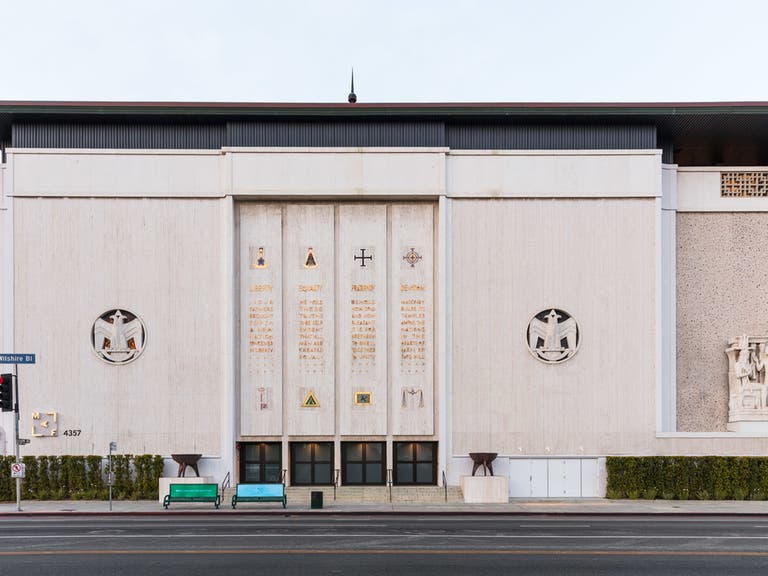
Scottish Rite Masonic Temple
Designed by Millard Sheets and built in 1961, the 110,000 square-foot Scottish Rite Masonic Temple is located on Wilshire Boulevard a few minutes from Koreatown. The Maurice and Paul Marciano Art Foundation bought the building in July 2013 - it was renovated and reopened in 2017 as a contemporary art space. The museum closed in late 2019.
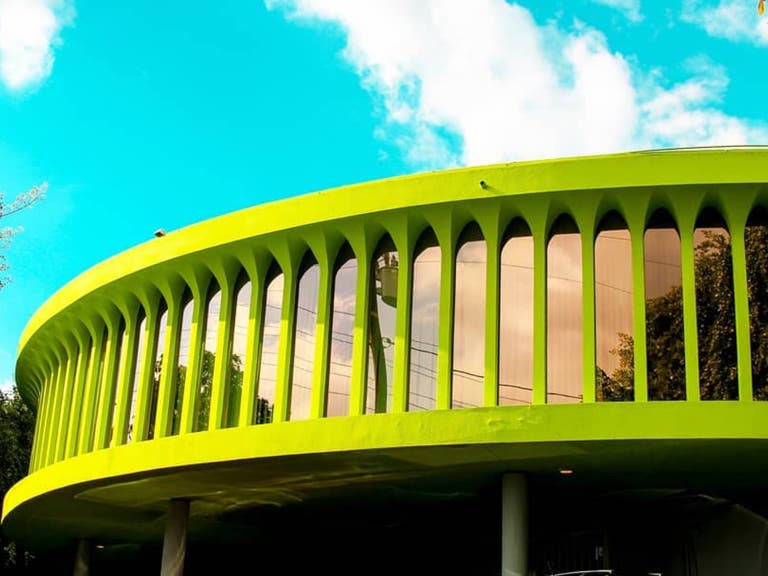
Mutato Muzika (Beauty Pavilion)
If you drive along the world-famous Sunset Strip in the daytime, it's nearly impossible to miss the bright green building at 8760 W. Sunset Blvd. Resembling a gamma ray-soaked version of The Forum in Inglewood, the circular building houses Mutato Muzika, the music production company owned by Mark Mothersbaugh, co-founder of the pioneering band, Devo. The 9,500 square-foot “Beauty Pavilion” building was built in 1967 for Dr. Richard Alan Franklyn, a cosmetic surgeon and author. According to the Los Angeles Conservancy, Dr. Franklyn wanted the building to be "designed expressly for doing plastic surgery, with natural light streaming in through central skylights to illuminate the operating room." Although there's no architect listed on the building permit, the building is rumored to be designed by famed Brazilian architect Oscar Niemeyer, who designed civic buildings for Brasilia and the United Nations headquarters in New York.
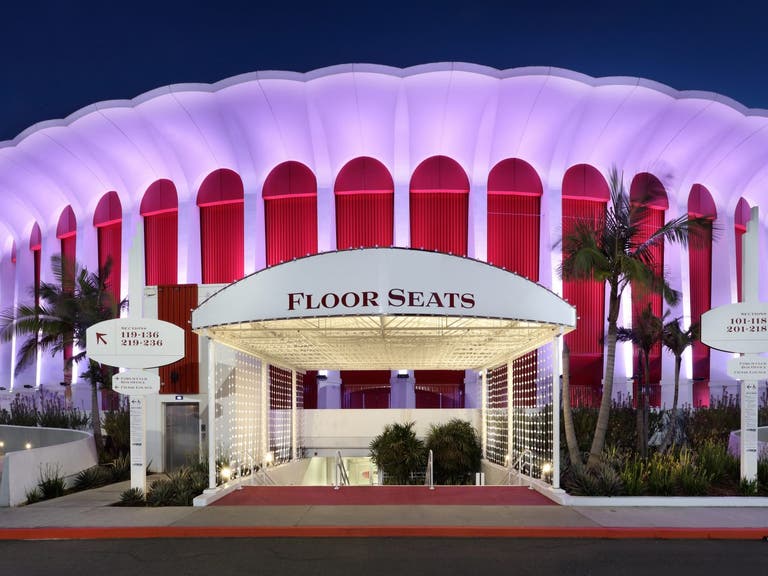
The Forum
The "Fabulous" Forum in Inglewood was originally built in 1967 to house the new LA Kings hockey franchise by owner Jack Kent Cooke, a Canadian hockey fan who also owned the Lakers at the time. Designed by Los Angeles architect Charles Luckman, the round building was meant to emulate the Roman Forum (no lions here) and is considered an architectural marvel as it has no major support pillars, an engineering feat for a building of its size. The Forum was one of LA's greatest sports and events venues, the home of the "Showtime" Lakers, the Great Gretzky, the "Miracle on Manchester" and countless music concerts.
After an extensive multi-million dollar renovation, The Forum celebrated its grand reopening as a world-class concert arena with a six-night stand by the Eagles in January 2014, and continues to book a wide range of top music acts and special events.
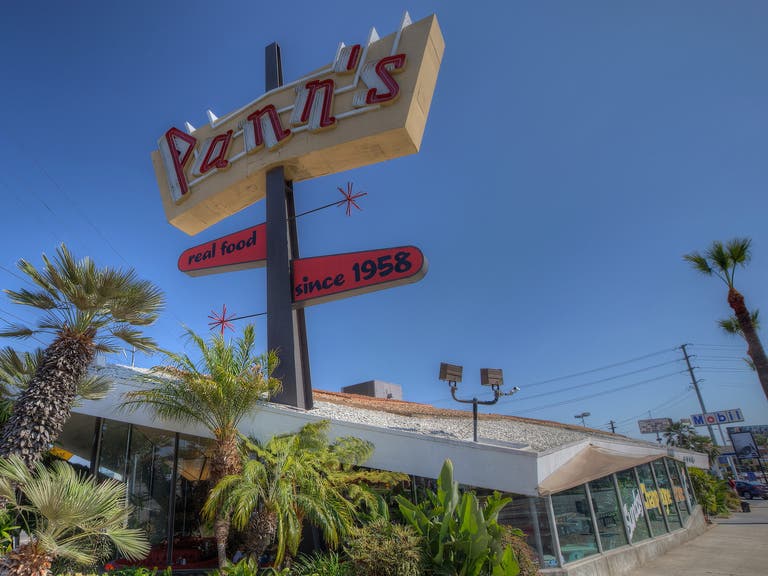
Pann’s
George and Rena Panagopoulos ran a pair of cafes before opening Pann’s near LAX in 1958, and son Jim carries on their legacy. Armet and Davis, also of NORM’s diner fame, created an iconic Googie design that includes a peaked roof, faux stone walls, speckled floor, glass fronted patio lined with plants and cacti, red cushioned booths with wood tables, geometric counter with cream colored stools, pyramid-shaped and cylindrical lantern. They still serve a heap of comfort food for breakfast and lunch, and the location is conveniently close to the airport for those fresh off a red eye from the East Coast.
Hanna-Barbera Building (LA Fitness)
For Baby Boomers and Gen-Xers, the name “Hanna-Barbera” brings up childhood memories of Saturday mornings watching beloved cartoons like The Flintstones, Yogi Bear, The Jetsons, Scooby-Doo and The Smurfs. Founded in 1957 by former MGM animation directors William Hanna and Joseph Barbera (the creators of Tom and Jerry), the Hanna-Barbera Studio moved into its Mid-Century building at 3400 W. Cahuenga Blvd. in 1963. Designed by architect Arthur Froehlich, the building now houses an LA Fitness location, so Modernism fans can get their Saturday morning workout in the place where cartoon history was created.
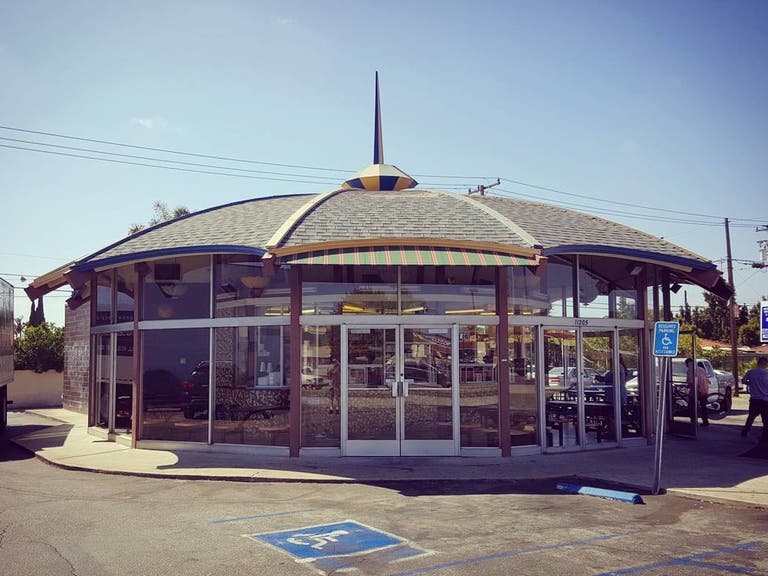
Brolly Hut
Brolly Hut is a recently recognized, umbrella-themed eatery designed by Victor Miller. Opened in 1968 as the Bumbershoot Café and thankfully still standing, Brolly Hut is another unique example of L.A.'s disappearing programmatic architecture - the umbrella shaped pavilion shelters quirky original light fixtures and still serves a mean onion ring. The uplifting hand lettered signage is worth a visit alone. Bonus points for being one of Ice Cube’s favorite buildings in Inglewood.
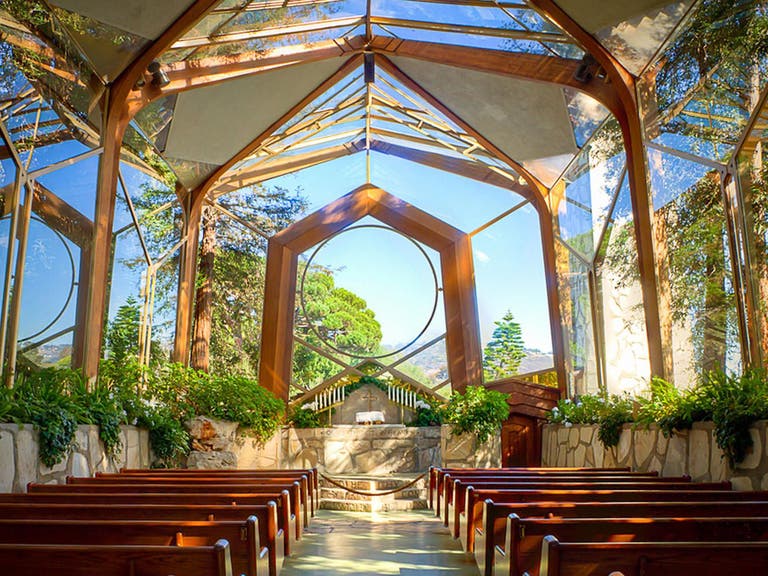
Wayfarers Chapel
The exquisite Wayfarers Chapel (aka “The Glass Church”) is located in Rancho Palos Verdes, situated on cliffs above the Pacific Ocean. Architect Lloyd Wright, son of the legendary architect Frank Lloyd Wright, conceived of Wayfarers Chapel as a “tree chapel,” a natural sanctuary set in the middle of a forest. Lloyd Wright’s design is regarded as one of the foremost examples of Organic Architecture, which promotes harmony between human habitation and the natural world. A popular wedding venue because of its spectacular design and location, the Wayfarers Chapel was featured prominently on “The O.C.” and appeared in other TV series like “90210.”
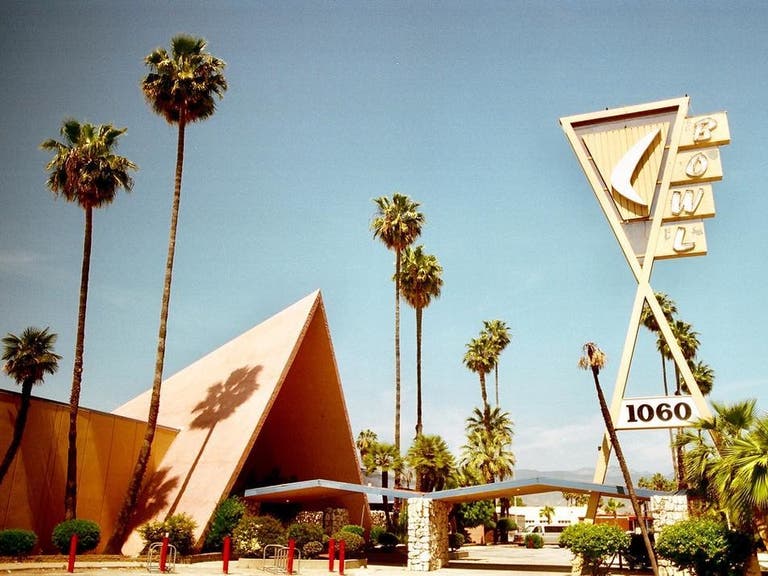
Covina Bowl
One of the most “exuberant” and sadly, last remaining Googie bowling alleys in Southern California, this gorgeous, weirdo Tiki/Egyptian inspired A-frame was built in 1956 during the heyday of bowling leagues and cocktail hours. Covina Bowl was designed in 1956 by Powers, Daly, & DeRosa, the architecture firm that was responsible for almost 50 other lavish bowling alleys in California, now mostly destroyed. In 2016, Covina Bowl was nominated for national historic monument status and other protections before closing its doors for good, in March 2017. Support the Friends of Covina Bowl to preserve this piece of unique SoCal history.
